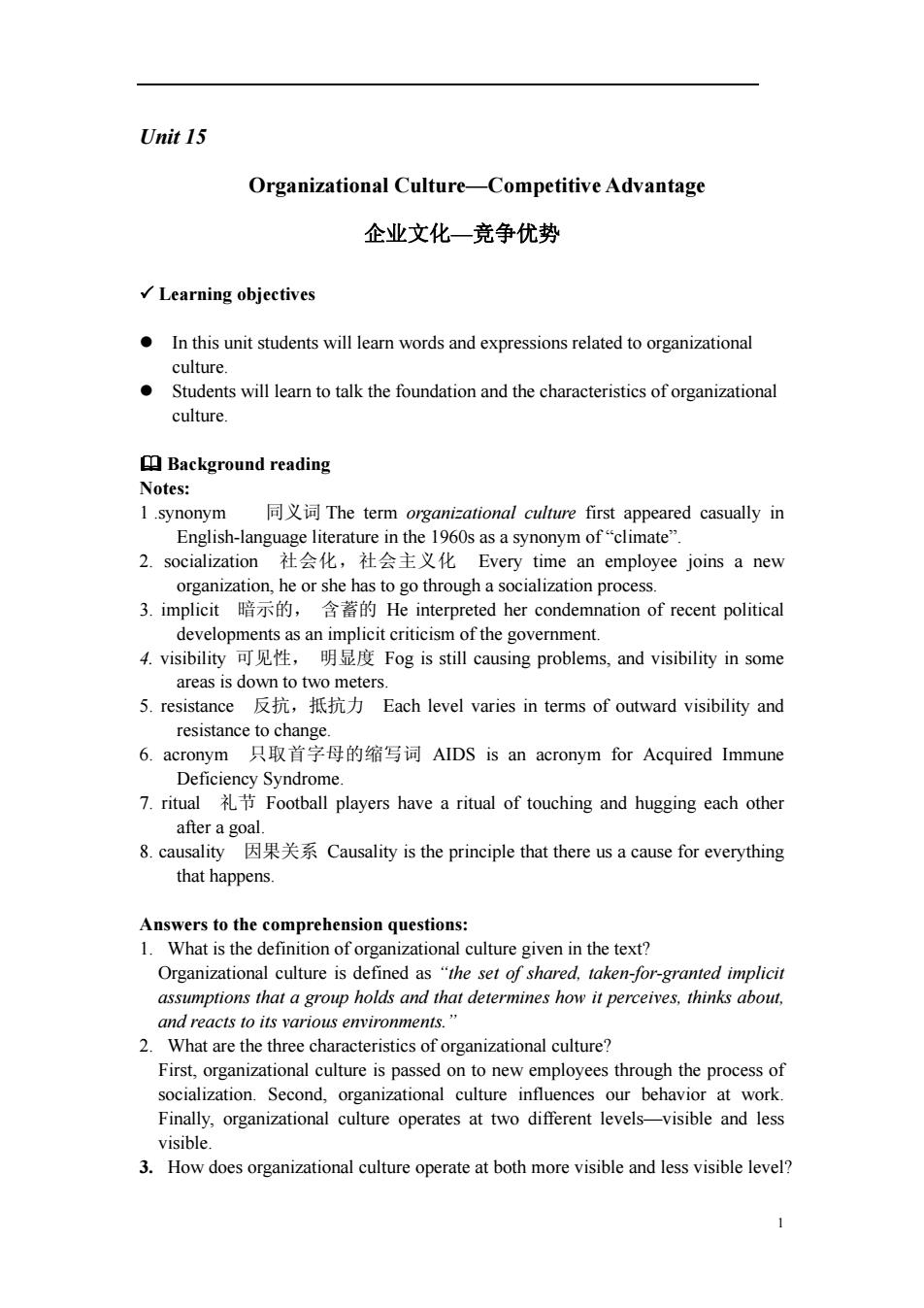
Unit 15 Organizational Culture-Competitive Advantage 企业文化一竞争优势 √Learning objectives In this unit students will learn words and expressions related to organizational culture. ● Students will learn to talk the foundation and the characteristics of organizational culture Background reading Notes: 1.synonym The term organizational culture first appeared casually in English-language literature in the 1960s as a synonym of"climate" 2.socialization社会化,社会主义化Every time an employee joins a new organization,he or she has to go through a socialization process. 3.implicit暗示的,含蓄的He interpreted her condemnation of recent political developments as an implicit criticism of the government. 4.visibility可见性,明显度Fog is still causing problems,and visibility in some areas is down to two meters. 5.resistance反抗,抵抗力Each level varies in terms of outward visibility and resistance to change. 6.acronym只取首字母的缩'写词AIDS is an acronym for Acquired Immune Deficiency Syndrome. 7.ritual Football players have a ritual of touching and hugging each other after a goal. &.causality因果关系Causality is the principle that there us a cause for everything that happens. Answers to the comprehension questions: 1.What is the definition of organizational culture given in the text? Organizational culture is defined as "the set of shared,taken-for-granted implicit assumptions that a group holds and that determines how it perceives,thinks about, and reacts to its various environments." 2.What are the three characteristics of organizational culture? First,organizational culture is passed on to new employees through the process of socialization.Second,organizational culture influences our behavior at work. Finally,organizational culture operates at two different levels-visible and less visible. 3.How does organizational culture operate at both more visible and less visible level?
Unit 15 Organizational Culture—Competitive Advantage 企业文化—竞争优势 3 Learning objectives z In this unit students will learn words and expressions related to organizational culture. z Students will learn to talk the foundation and the characteristics of organizational culture. Background reading Notes: 1 .synonym 同义词 The term organizational culture first appeared casually in English-language literature in the 1960s as a synonym of “climate”. 2. socialization 社会化,社会主义化 Every time an employee joins a new organization, he or she has to go through a socialization process. 3. implicit 暗示的, 含蓄的 He interpreted her condemnation of recent political developments as an implicit criticism of the government. 4. visibility 可见性, 明显度 Fog is still causing problems, and visibility in some areas is down to two meters. 5. resistance 反抗,抵抗力 Each level varies in terms of outward visibility and resistance to change. 6. acronym 只取首字母的缩写词 AIDS is an acronym for Acquired Immune Deficiency Syndrome. 7. ritual 礼节 Football players have a ritual of touching and hugging each other after a goal. 8. causality 因果关系 Causality is the principle that there us a cause for everything that happens. Answers to the comprehension questions: 1. What is the definition of organizational culture given in the text? Organizational culture is defined as “the set of shared, taken-for-granted implicit assumptions that a group holds and that determines how it perceives, thinks about, and reacts to its various environments.” 2. What are the three characteristics of organizational culture? First, organizational culture is passed on to new employees through the process of socialization. Second, organizational culture influences our behavior at work. Finally, organizational culture operates at two different levels—visible and less visible. 3. How does organizational culture operate at both more visible and less visible level? 1

Give examples to illustrate. At the more visible level,culture represents artifacts.Artifacts consist of the physical manifestation of an organization's culture.Organizational examples include acronyms,matter of dress,awards,myths and stories told about the organization,published lists of values,observable rituals and ceremonies,special parking spaces,decorations,and so on.At the less visible level,culture reflects the values and beliefs shared among organizational members.These values tend to persist over time and more resistant to change.These values tend to persist over time and are more resistant to change. 4.How do you understand Vijay Sathe's Model for observing and interpreting organizational Culture? Translation of background reading 什么是企业文化? 20世纪60年代,“组织文化”(organizational culture)一词非正式地初现于英文中,与 “氛围”(climate)同义。与之相当的“企业文化”(corporate culture)一词,首现于70年代。 1982年泰伦斯.狄尔(Terrence Deal)和艾伦.肯尼迪(Allan Kennedy)合著的书以“企业文化” (corporate culture)一词命名,在美国出版后,该词得到普遍使用。日后,有关这一话题的 文献广泛出现,并见于其他语言,例如中文里的“企业文化”一词。 如果你正在向一个外国公司申请工作,或正在一个外国公司工作,了解该公司的组织文 化特点是非常有益的。不适应就无法取得进展。每当雇员加入到一个新的组织中,他/她必 须经历一个社会化的过程,就如同在一个社会中成长。每个雇员都要弄清所有的含义和行为 一一哪些是好的成绩,而哪些不是;什么时候该用怎么样的方法与谁沟通;从千百种 不同工作经历中应该得到什么一简言之,即组织文化。由于受国别文化的影响,面试官和 经理通常很难描述清楚公司的组织文化,因为他们将其视为理所当然的。 因此,组织文化被定义为,“一系列组织成员所共有,并视为理所当然的隐含的假定, 这些假定决定了该组织如何感受、思考各种外界环境及如何反应。”这一定义突出了组织文 化的三个重要特点。首先,组织文化通过社会化的过程传递给新的雇员。其次,组织文化影 响我们工作中的行为。最后,组织文化在两个不同的层面运行。每个层面都会在外在可见度 和不易改变性两个方面变化。 在显性层面上,文化代表了人造物。人造物由一个组织文化的物质表现组成。组织中 的实例包括首字母缩写词,服装材质,所获奖励,关于该组织的传说和故事,公布的价值观 列表,可观看的仪式和庆典,特殊停车位,装饰装潢,等等。这个层面还包括成员及整个团 队的显性行为。与组织文化中不易见隐性的方面相比,人造物较易改变。在隐性的层面,文 化反映组织成员共有的价值观和信念。这些价值观往往持续时间很长且更不易改变。 文化的一个层面总会影响另一个层面。举例来说,如果一个公司的确重视提供高品质服 务,其雇员通常会更快速地回应顾客投诉。相似的,因果关系也可以翻转过来。在与顾客沟 通交流的实践经历中,雇员也可能渐渐重视起高质量服务来。 什么情况下一个组织的文化最为显著?除组织文化的物质人造物以外,文化假定通过新 雇员的社会化、亚文化碰撞,和高层管理行为坚持表现出来。请思考以下三种情况:一个新 雇员在一次重要会议上迟到,他被告知以前曾有一位雇员因多次迟到被解雇。产品设计工程 2
Give examples to illustrate. At the more visible level, culture represents artifacts. Artifacts consist of the physical manifestation of an organization’s culture. Organizational examples include acronyms, matter of dress, awards, myths and stories told about the organization, published lists of values, observable rituals and ceremonies, special parking spaces, decorations, and so on. At the less visible level, culture reflects the values and beliefs shared among organizational members. These values tend to persist over time and more resistant to change. These values tend to persist over time and are more resistant to change. 4. How do you understand Vijay Sathe’s Model for observing and interpreting organizational Culture? Translation of background reading 什么是企业文化? 20 世纪 60 年代,“组织文化”(organizational culture)一词非正式地初现于英文中,与 “氛围”(climate)同义。与之相当的“企业文化”(corporate culture)一词,首现于 70 年代。 1982 年泰伦斯.狄尔(Terrence Deal) 和艾伦.肯尼迪(Allan Kennedy)合著的书以“企业文化” (corporate culture)一词命名,在美国出版后,该词得到普遍使用。日后,有关这一话题的 文献广泛出现,并见于其他语言,例如中文里的“企业文化”一词。 如果你正在向一个外国公司申请工作,或正在一个外国公司工作,了解该公司的组织文 化特点是非常有益的。不适应就无法取得进展。每当雇员加入到一个新的组织中,他/她必 须经历一个社会化的过程,就如同在一个社会中成长。每个雇员都要弄清所有的含义和行为 ——哪些是好的成绩,而哪些不是;什么时候该用怎么样的方法与谁沟通;从千百种 不同工作经历中应该得到什么——简言之,即组织文化。由于受国别文化的影响,面试官和 经理通常很难描述清楚公司的组织文化,因为他们将其视为理所当然的。 因此,组织文化被定义为,“一系列组织成员所共有,并视为理所当然的隐含的假定, 这些假定决定了该组织如何感受、思考各种外界环境及如何反应。”这一定义突出了组织文 化的三个重要特点。首先,组织文化通过社会化的过程传递给新的雇员。其次,组织文化影 响我们工作中的行为。最后,组织文化在两个不同的层面运行。每个层面都会在外在可见度 和不易改变性两个方面变化。 在显性层面上,文化代表了人造物。人造物由一个组织文化的物质表现组成。组织中 的实例包括首字母缩写词,服装材质,所获奖励,关于该组织的传说和故事,公布的价值观 列表,可观看的仪式和庆典,特殊停车位,装饰装潢,等等。这个层面还包括成员及整个团 队的显性行为。与组织文化中不易见隐性的方面相比,人造物较易改变。在隐性的层面,文 化反映组织成员共有的价值观和信念。这些价值观往往持续时间很长且更不易改变。 文化的一个层面总会影响另一个层面。举例来说,如果一个公司的确重视提供高品质服 务,其雇员通常会更快速地回应顾客投诉。相似的,因果关系也可以翻转过来。在与顾客沟 通交流的实践经历中,雇员也可能渐渐重视起高质量服务来。 什么情况下一个组织的文化最为显著?除组织文化的物质人造物以外,文化假定通过新 雇员的社会化、亚文化碰撞,和高层管理行为坚持表现出来。请思考以下三种情况:一个新 雇员在一次重要会议上迟到,他被告知以前曾有一位雇员因多次迟到被解雇。产品设计工程 2
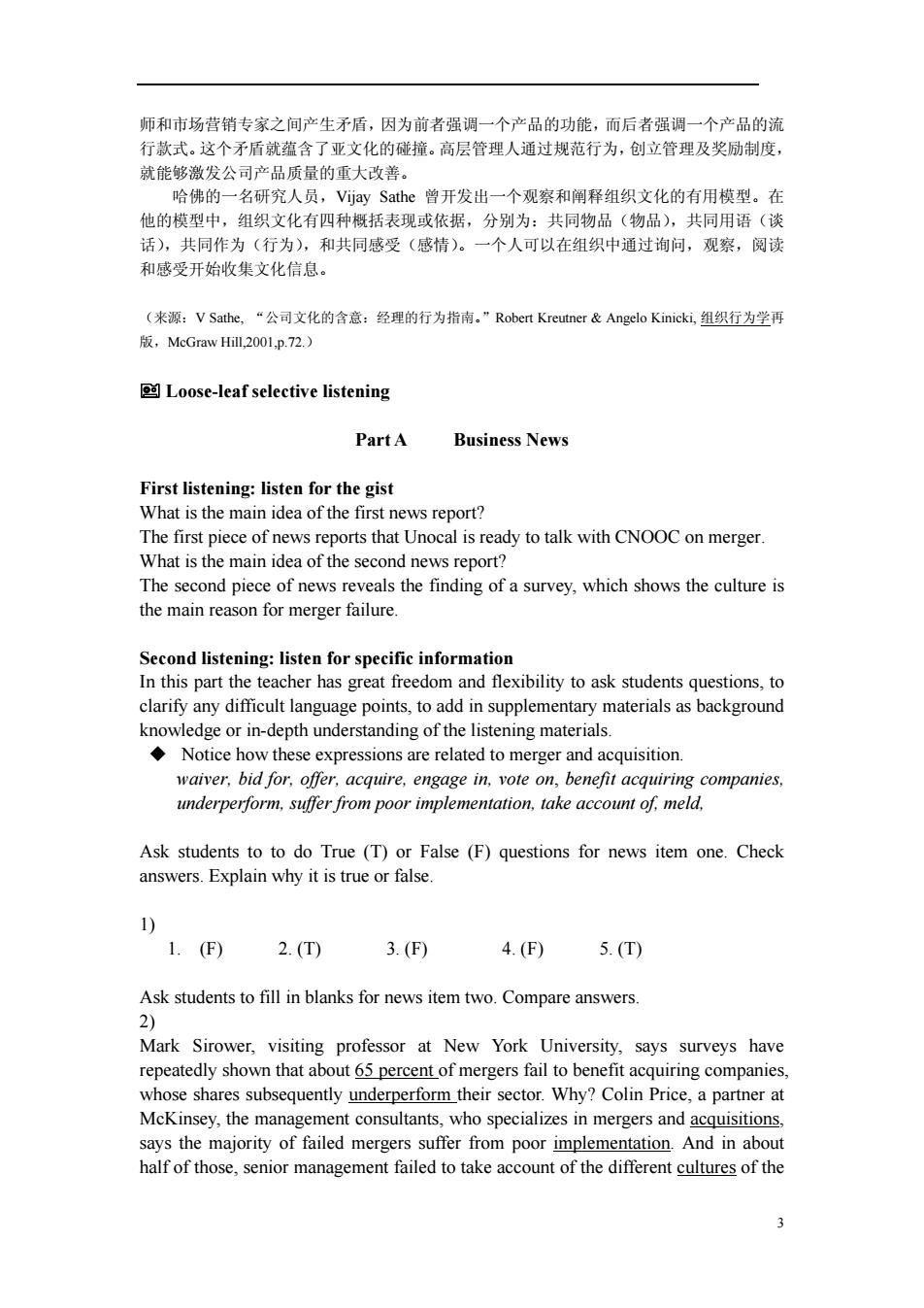
师和市场营销专家之间产生矛盾,因为前者强调一个产品的功能,而后者强调一个产品的流 行款式。这个矛盾就蕴含了亚文化的碰撞。高层管理人通过规范行为,创立管理及奖励制度, 就能够激发公司产品质量的重大改善。 哈佛的一名研究人员,Vijay Sathe曾开发出一个观察和阐释组织文化的有用模型。在 他的模型中,组织文化有四种概括表现或依据,分别为:共同物品(物品),共同用语(谈 话),共同作为(行为),和共同感受(感情)。一个人可以在组织中通过询问,观察,阅读 和感受开始收集文化信息。 (来源:V Sathe,“公司文化的含意:经理的行为指南。”Robert Kreutner&Angelo Kinicki,组织行为学再 版,McGraw Hill,2001,p.72.) Loose-leaf selective listening PartA Business News First listening:listen for the gist What is the main idea of the first news report? The first piece of news reports that Unocal is ready to talk with CNOOC on merger. What is the main idea of the second news report? The second piece of news reveals the finding of a survey,which shows the culture is the main reason for merger failure. Second listening:listen for specific information In this part the teacher has great freedom and flexibility to ask students questions,to clarify any difficult language points,to add in supplementary materials as background knowledge or in-depth understanding of the listening materials. Notice how these expressions are related to merger and acquisition. waiver,bid for,offer,acquire,engage in,vote on,benefit acquiring companies, underperform,suffer from poor implementation,take account of,meld, Ask students toto do True (T)or False (F)questions for news item one.Check answers.Explain why it is true or false. 1) 1.(F) 2.(T) 3.(F) 4.(F) 5.(T) Ask students to fill in blanks for news item two.Compare answers. 2) Mark Sirower,visiting professor at New York University,says surveys have repeatedly shown that about 65 percent of mergers fail to benefit acquiring companies, whose shares subsequently underperform their sector.Why?Colin Price,a partner at McKinsey,the management consultants,who specializes in mergers and acquisitions, says the majority of failed mergers suffer from poor implementation.And in about half of those,senior management failed to take account of the different cultures of the 3
师和市场营销专家之间产生矛盾,因为前者强调一个产品的功能,而后者强调一个产品的流 行款式。这个矛盾就蕴含了亚文化的碰撞。高层管理人通过规范行为,创立管理及奖励制度, 就能够激发公司产品质量的重大改善。 哈佛的一名研究人员,Vijay Sathe 曾开发出一个观察和阐释组织文化的有用模型。在 他的模型中,组织文化有四种概括表现或依据,分别为:共同物品(物品),共同用语(谈 话),共同作为(行为),和共同感受(感情)。一个人可以在组织中通过询问,观察,阅读 和感受开始收集文化信息。 (来源:V Sathe, “公司文化的含意:经理的行为指南。”Robert Kreutner & Angelo Kinicki, 组织行为学再 版,McGraw Hill,2001,p.72.) Loose-leaf selective listening Part A Business News First listening: listen for the gist What is the main idea of the first news report? The first piece of news reports that Unocal is ready to talk with CNOOC on merger. What is the main idea of the second news report? The second piece of news reveals the finding of a survey, which shows the culture is the main reason for merger failure. Second listening: listen for specific information In this part the teacher has great freedom and flexibility to ask students questions, to clarify any difficult language points, to add in supplementary materials as background knowledge or in-depth understanding of the listening materials. Notice how these expressions are related to merger and acquisition. waiver, bid for, offer, acquire, engage in, vote on, benefit acquiring companies, underperform, suffer from poor implementation, take account of, meld, Ask students to to do True (T) or False (F) questions for news item one. Check answers. Explain why it is true or false. 1) 1. (F) 2. (T) 3. (F) 4. (F) 5. (T) Ask students to fill in blanks for news item two. Compare answers. 2) Mark Sirower, visiting professor at New York University, says surveys have repeatedly shown that about 65 percent of mergers fail to benefit acquiring companies, whose shares subsequently underperform their sector. Why? Colin Price, a partner at McKinsey, the management consultants, who specializes in mergers and acquisitions, says the majority of failed mergers suffer from poor implementation. And in about half of those, senior management failed to take account of the different cultures of the 3

companies involved. Melding corporate cultures takes time,which senior management does not have after a merger.Mr.Price says."Most mergers are based on the idea of 'let's increase revenues',but you have to have a functioning management team to manage that process.The nature of the problem is not so much that there's open warfare between the two sides.It's that the cultures don't meld quickly enough to take advantage of the opportunities.In the meantime,the marketplace has moved on. Third listening:sentences imitation Ask students to use the following active vocabularies to form sentences as what they have heard from listening (Dictate then remember). Please first write down the following words on the blackboard or computer.Then ask students to listen for sentences with these words in them.You ask them to listen two times and see who has caught more sentences. 1.waver--Unocal Corp.said on Thursday that it has got a waiver from Chevron Corp 2.to commence--Unocal intends promptly to commence discussions with China National Offshore Oil Corporation(CNOOC)Ltd.on its proposed merger. 3.bid--CNOOC's proposed merger offer is two dollars higher than Chevron's April bid for Unocal a share. 4.to engage in--Unocal got a permission from Chevron to engage in discussions with CNOOC Ltd.and its representatives at any time. 5.to vote on--until the date of the Unocal stockholders yoting on the proposed merger with Chevron. 6.to contract--He has contracted the habit of talking to himself. 7.to underperform--Surveys have repeatedly shown that about 65 percent of mergers fail to benefit acquiring companies,whose shares subsequently underperform their sector 8.to take account of--And in about half of those,senior management failed to take account of the different cultures of the companies involved. 9.to meld--It's that the cultures don't meld quickly enough to take advantage of the opportunities. Part B Cultural Models of Organization First listening:listen for the gist What is the main idea of the report? The first passage is about Stevens'observation about organizational culture. Second listening:listen for specific information In this part the teacher has great freedom and flexibility to ask students questions,to clarify any difficult language points,to add in supplementary materials as background knowledge or in-depth understanding of the listening materials. 4
companies involved. Melding corporate cultures takes time, which senior management does not have after a merger. Mr. Price says. “Most mergers are based on the idea of ‘let’s increase revenues’, but you have to have a functioning management team to manage that process. The nature of the problem is not so much that there’s open warfare between the two sides. It’s that the cultures don’t meld quickly enough to take advantage of the opportunities. In the meantime, the marketplace has moved on. Third listening: sentences imitation Ask students to use the following active vocabularies to form sentences as what they have heard from listening (Dictate then remember). Please first write down the following words on the blackboard or computer. Then ask students to listen for sentences with these words in them. You ask them to listen two times and see who has caught more sentences. 1. waver--Unocal Corp. said on Thursday that it has got a waiver from Chevron Corp. 2. to commence--Unocal intends promptly to commence discussions with China National Offshore Oil Corporation (CNOOC) Ltd. on its proposed merger. 3. bid--CNOOC’s proposed merger offer is two dollars higher than Chevron's April bid for Unocal a share. 4. to engage in--Unocal got a permission from Chevron to engage in discussions with CNOOC Ltd. and its representatives at any time. 5. to vote on--until the date of the Unocal stockholders voting on the proposed merger with Chevron. 6. to contract--He has contracted the habit of talking to himself. 7. to underperform--Surveys have repeatedly shown that about 65 percent of mergers fail to benefit acquiring companies, whose shares subsequently underperform their sector. 8. to take account of--And in about half of those, senior management failed to take account of the different cultures of the companies involved. 9. to meld--It’s that the cultures don’t meld quickly enough to take advantage of the opportunities. Part B Cultural Models of Organization First listening: listen for the gist What is the main idea of the report? The first passage is about Stevens’ observation about organizational culture. Second listening: listen for specific information In this part the teacher has great freedom and flexibility to ask students questions, to clarify any difficult language points, to add in supplementary materials as background knowledge or in-depth understanding of the listening materials. 4
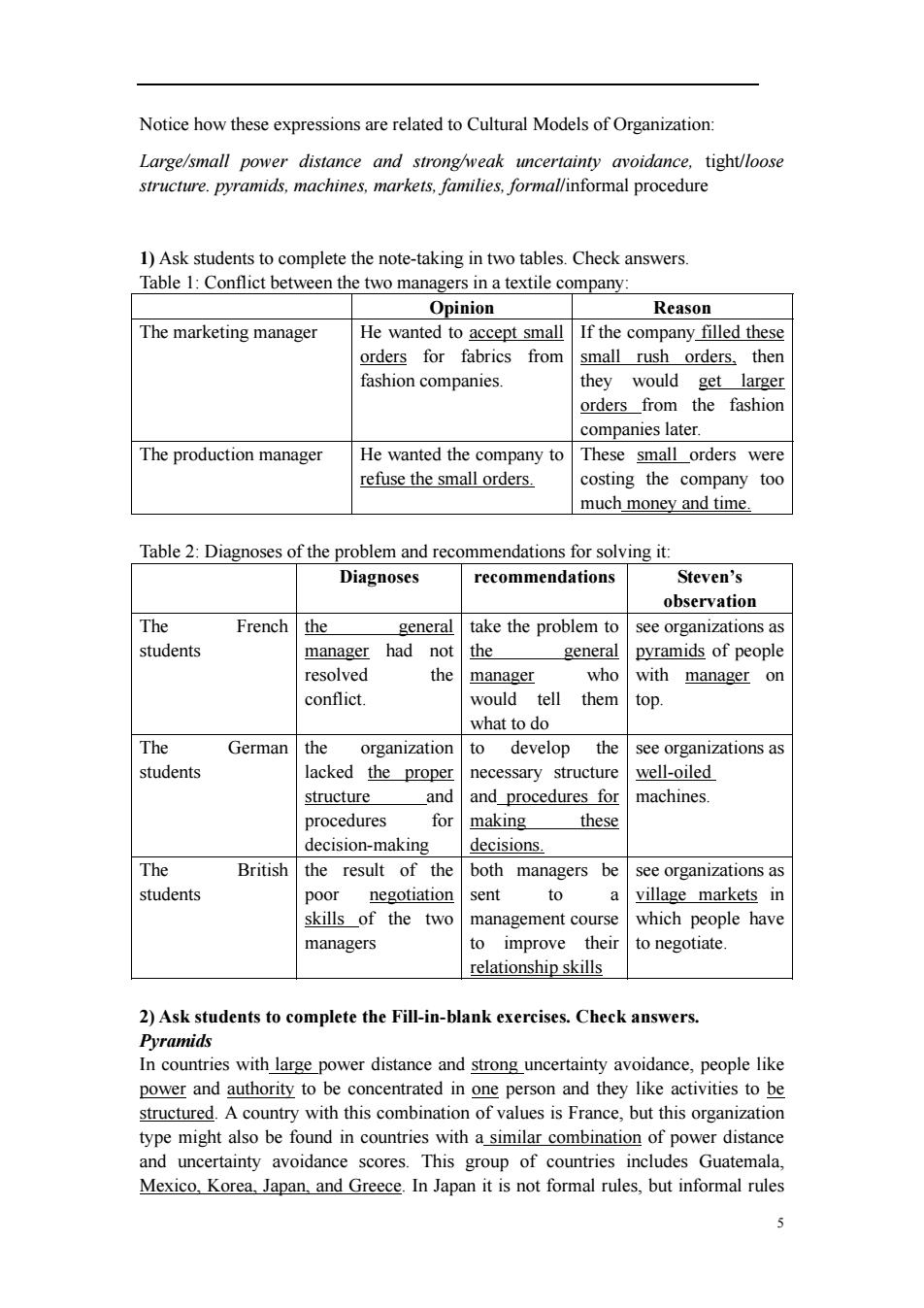
Notice how these expressions are related to Cultural Models of Organization: Large/small power distance and strong/weak uncertainty avoidance,tight/loose structure.pyramids,machines,markets,families,formal/informal procedure 1)Ask students to complete the note-taking in two tables.Check answers. Table 1:Conflict between the two managers in a textile company: Opinion Reason The marketing manager He wanted to accept small If the company filled these orders for fabrics from small rush orders,then fashion companies. they would get larger orders from the fashion companies later. The production manager He wanted the company to These small orders were refuse the small orders. costing the company too much money and time Table 2:Diagnoses of the problem and recommendations for solving it: Diagnoses recommendations Steven's observation The French the general take the problem to see organizations as students manager had not the general pyramids of people resolved the manager who with manager on conflict. would tell them top. what to do The German the organization to develop the see organizations as students lacked the proper necessary structure well-oiled structure and and_procedures for machines. procedures for making these decision-making decisions. The British the result of the both managers be see organizations as students poor negotiation sent to village markets in skills of the two management course which people have managers to improve their to negotiate. relationship skills 2)Ask students to complete the Fill-in-blank exercises.Check answers. Pyramids In countries with large power distance and strong uncertainty avoidance,people like power and authority to be concentrated in one person and they like activities to be structured.A country with this combination of values is France,but this organization type might also be found in countries with a similar combination of power distance and uncertainty avoidance scores.This group of countries includes Guatemala, Mexico,Korea,Japan,and Greece.In Japan it is not formal rules,but informal rules 5
Notice how these expressions are related to Cultural Models of Organization: Large/small power distance and strong/weak uncertainty avoidance, tight/loose structure. pyramids, machines, markets, families, formal/informal procedure 1) Ask students to complete the note-taking in two tables. Check answers. Table 1: Conflict between the two managers in a textile company: Opinion Reason The marketing manager He wanted to accept small orders for fabrics from fashion companies. If the company filled these small rush orders, then they would get larger orders from the fashion companies later. The production manager He wanted the company to refuse the small orders. These small orders were costing the company too much money and time. Table 2: Diagnoses of the problem and recommendations for solving it: Diagnoses recommendations Steven’s observation The French students the general manager had not resolved the conflict. take the problem to the general manager who would tell them what to do see organizations as pyramids of people with manager on top. The German students the organization lacked the proper structure and procedures for decision-making to develop the necessary structure and procedures for making these decisions. see organizations as well-oiled machines. The British students the result of the poor negotiation skills of the two managers both managers be sent to a management course to improve their relationship skills see organizations as village markets in which people have to negotiate. 2) Ask students to complete the Fill-in-blank exercises. Check answers. Pyramids In countries with large power distance and strong uncertainty avoidance, people like power and authority to be concentrated in one person and they like activities to be structured. A country with this combination of values is France, but this organization type might also be found in countries with a similar combination of power distance and uncertainty avoidance scores. This group of countries includes Guatemala, Mexico, Korea, Japan, and Greece. In Japan it is not formal rules, but informal rules 5
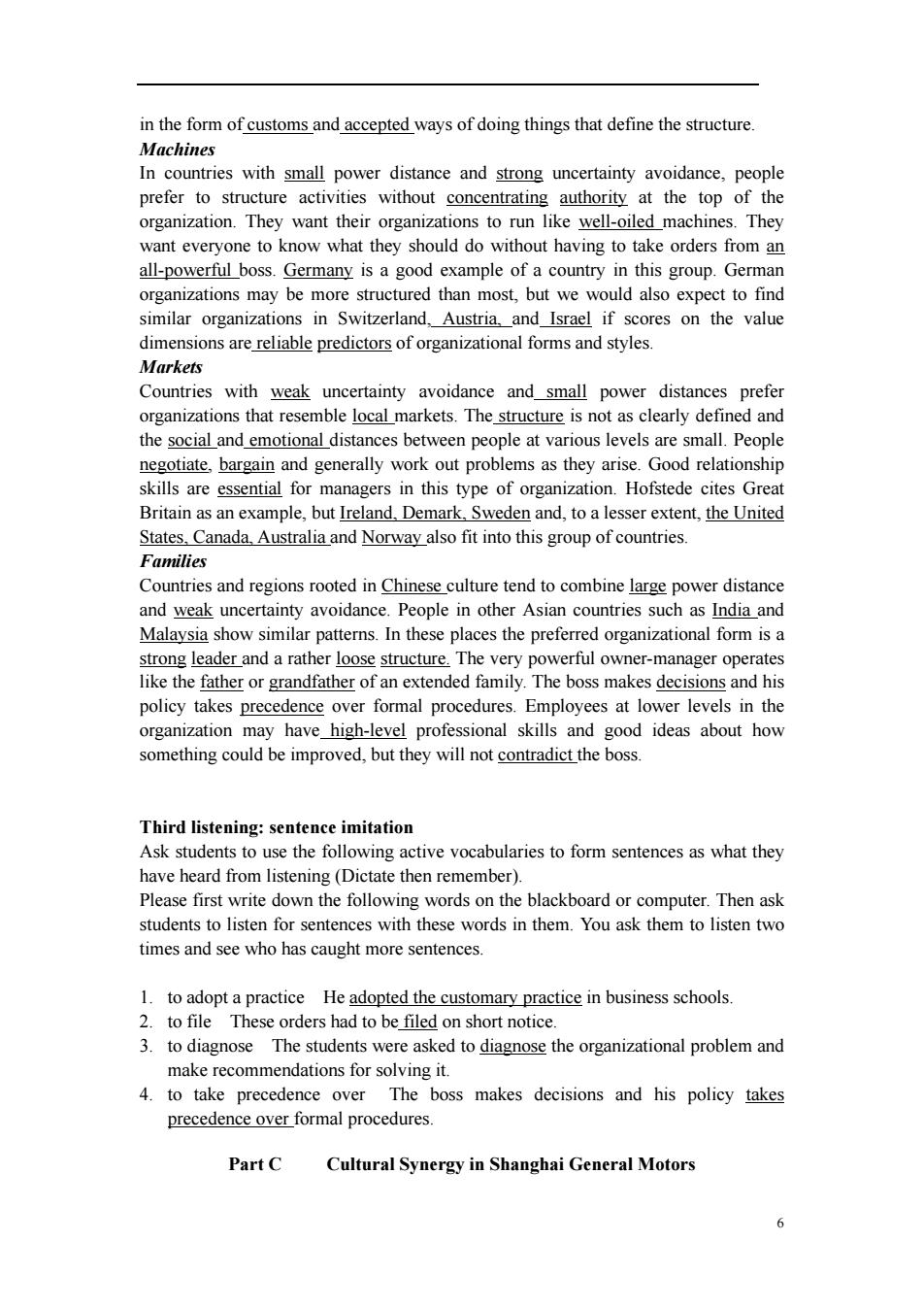
in the form of customs and accepted ways of doing things that define the structure. Machines In countries with small power distance and strong uncertainty avoidance,people prefer to structure activities without concentrating authority at the top of the organization.They want their organizations to run like well-oiled machines.They want everyone to know what they should do without having to take orders from an all-powerful boss.Germany is a good example of a country in this group.German organizations may be more structured than most,but we would also expect to find similar organizations in Switzerland,Austria,and Israel if scores on the value dimensions are reliable predictors of organizational forms and styles. Markets Countries with weak uncertainty avoidance and small power distances prefer organizations that resemble local markets.The structure is not as clearly defined and the social and emotional distances between people at various levels are small.People negotiate,bargain and generally work out problems as they arise.Good relationship skills are essential for managers in this type of organization.Hofstede cites Great Britain as an example,but Ireland,Demark,Sweden and,to a lesser extent,the United States,Canada,Australia and Norway also fit into this group of countries. Families Countries and regions rooted in Chinese culture tend to combine large power distance and weak uncertainty avoidance.People in other Asian countries such as India and Malaysia show similar patterns.In these places the preferred organizational form is a strong leader and a rather loose structure.The very powerful owner-manager operates like the father or grandfather of an extended family.The boss makes decisions and his policy takes precedence over formal procedures.Employees at lower levels in the organization may have_high-level professional skills and good ideas about how something could be improved,but they will not contradict the boss. Third listening:sentence imitation Ask students to use the following active vocabularies to form sentences as what they have heard from listening(Dictate then remember). Please first write down the following words on the blackboard or computer.Then ask students to listen for sentences with these words in them.You ask them to listen two times and see who has caught more sentences. 1.to adopt a practice He adopted the customary practice in business schools 2.to file These orders had to be filed on short notice. 3.to diagnose The students were asked to diagnose the organizational problem and make recommendations for solving it. 4.to take precedence over The boss makes decisions and his policy takes precedence over formal procedures. Part C Cultural Synergy in Shanghai General Motors 6
in the form of customs and accepted ways of doing things that define the structure. Machines In countries with small power distance and strong uncertainty avoidance, people prefer to structure activities without concentrating authority at the top of the organization. They want their organizations to run like well-oiled machines. They want everyone to know what they should do without having to take orders from an all-powerful boss. Germany is a good example of a country in this group. German organizations may be more structured than most, but we would also expect to find similar organizations in Switzerland, Austria, and Israel if scores on the value dimensions are reliable predictors of organizational forms and styles. Markets Countries with weak uncertainty avoidance and small power distances prefer organizations that resemble local markets. The structure is not as clearly defined and the social and emotional distances between people at various levels are small. People negotiate, bargain and generally work out problems as they arise. Good relationship skills are essential for managers in this type of organization. Hofstede cites Great Britain as an example, but Ireland, Demark, Sweden and, to a lesser extent, the United States, Canada, Australia and Norway also fit into this group of countries. Families Countries and regions rooted in Chinese culture tend to combine large power distance and weak uncertainty avoidance. People in other Asian countries such as India and Malaysia show similar patterns. In these places the preferred organizational form is a strong leader and a rather loose structure. The very powerful owner-manager operates like the father or grandfather of an extended family. The boss makes decisions and his policy takes precedence over formal procedures. Employees at lower levels in the organization may have high-level professional skills and good ideas about how something could be improved, but they will not contradict the boss. Third listening: sentence imitation Ask students to use the following active vocabularies to form sentences as what they have heard from listening (Dictate then remember). Please first write down the following words on the blackboard or computer. Then ask students to listen for sentences with these words in them. You ask them to listen two times and see who has caught more sentences. 1. to adopt a practice He adopted the customary practice in business schools. 2. to file These orders had to be filed on short notice. 3. to diagnose The students were asked to diagnose the organizational problem and make recommendations for solving it. 4. to take precedence over The boss makes decisions and his policy takes precedence over formal procedures. Part C Cultural Synergy in Shanghai General Motors 6
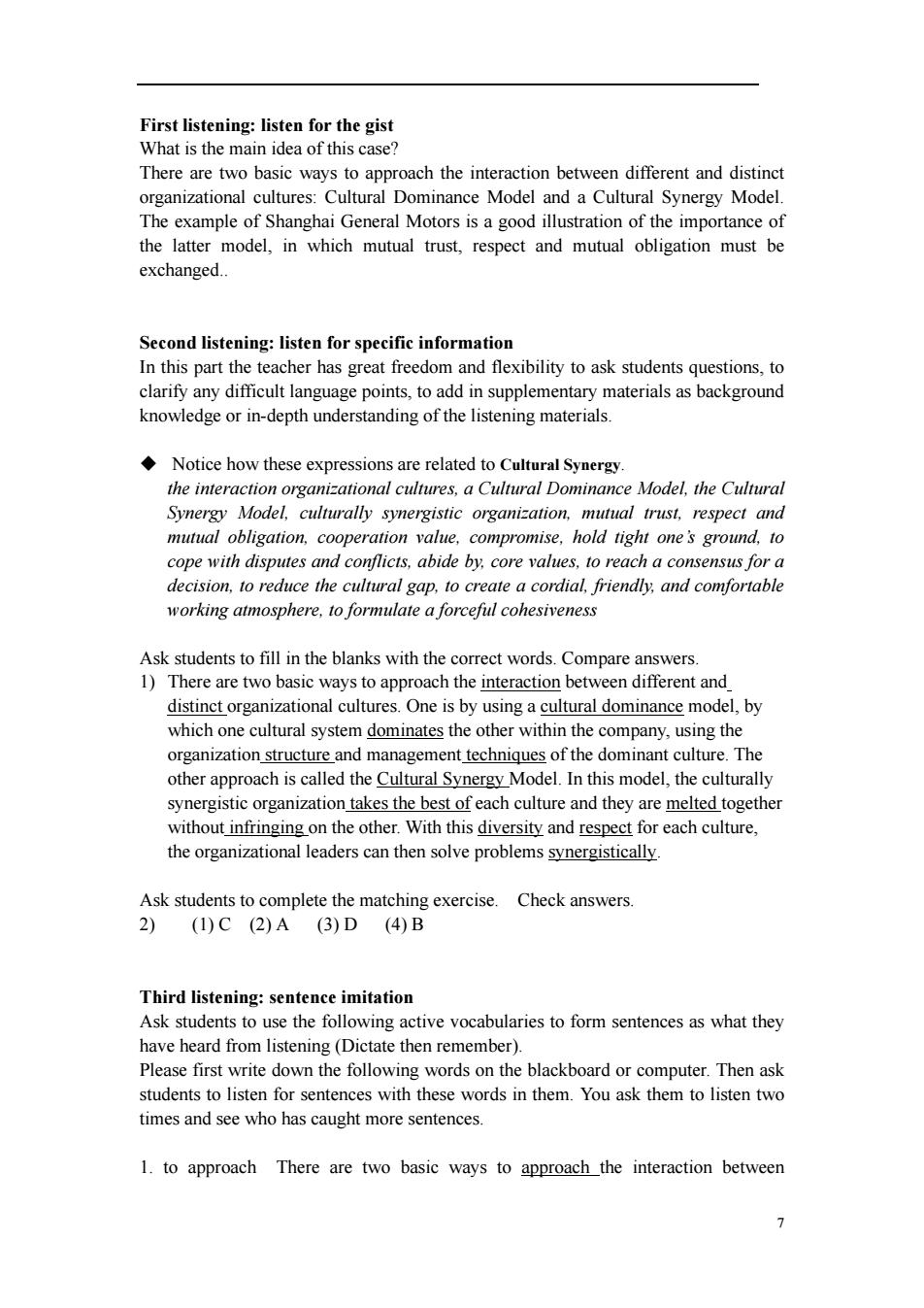
First listening:listen for the gist What is the main idea of this case? There are two basic ways to approach the interaction between different and distinct organizational cultures:Cultural Dominance Model and a Cultural Synergy Model. The example of Shanghai General Motors is a good illustration of the importance of the latter model,in which mutual trust,respect and mutual obligation must be exchanged.. Second listening:listen for specific information In this part the teacher has great freedom and flexibility to ask students questions,to clarify any difficult language points,to add in supplementary materials as background knowledge or in-depth understanding of the listening materials. Notice how these expressions are related to Cultural Synergy. the interaction organizational cultures,a Cultural Dominance Model,the Cultural Synergy Model,culturally synergistic organization,mutual trust,respect and mutual obligation,cooperation value,compromise,hold tight one's ground,to cope with disputes and conflicts,abide by,core values,to reach a consensus for a decision,to reduce the cultural gap,to create a cordial,friendly,and comfortable working atmosphere,to formulate a forceful cohesiveness Ask students to fill in the blanks with the correct words.Compare answers. 1)There are two basic ways to approach the interaction between different and distinct organizational cultures.One is by using a cultural dominance model,by which one cultural system dominates the other within the company,using the organization structure and management techniques of the dominant culture.The other approach is called the Cultural Synergy Model.In this model,the culturally synergistic organization takes the best of each culture and they are melted together without infringing on the other.With this diversity and respect for each culture, the organizational leaders can then solve problems synergistically. Ask students to complete the matching exercise.Check answers. 2)(1)C(2)A(3)D(4)B Third listening:sentence imitation Ask students to use the following active vocabularies to form sentences as what they have heard from listening (Dictate then remember). Please first write down the following words on the blackboard or computer.Then ask students to listen for sentences with these words in them.You ask them to listen two times and see who has caught more sentences. 1.to approach There are two basic ways to approach_the interaction between 7
First listening: listen for the gist What is the main idea of this case? There are two basic ways to approach the interaction between different and distinct organizational cultures: Cultural Dominance Model and a Cultural Synergy Model. The example of Shanghai General Motors is a good illustration of the importance of the latter model, in which mutual trust, respect and mutual obligation must be exchanged.. Second listening: listen for specific information In this part the teacher has great freedom and flexibility to ask students questions, to clarify any difficult language points, to add in supplementary materials as background knowledge or in-depth understanding of the listening materials. Notice how these expressions are related to Cultural Synergy. the interaction organizational cultures, a Cultural Dominance Model, the Cultural Synergy Model, culturally synergistic organization, mutual trust, respect and mutual obligation, cooperation value, compromise, hold tight one’s ground, to cope with disputes and conflicts, abide by, core values, to reach a consensus for a decision, to reduce the cultural gap, to create a cordial, friendly, and comfortable working atmosphere, to formulate a forceful cohesiveness Ask students to fill in the blanks with the correct words. Compare answers. 1) There are two basic ways to approach the interaction between different and distinct organizational cultures. One is by using a cultural dominance model, by which one cultural system dominates the other within the company, using the organization structure and management techniques of the dominant culture. The other approach is called the Cultural Synergy Model. In this model, the culturally synergistic organization takes the best of each culture and they are melted together without infringing on the other. With this diversity and respect for each culture, the organizational leaders can then solve problems synergistically. Ask students to complete the matching exercise. Check answers. 2) (1) C (2) A (3) D (4) B Third listening: sentence imitation Ask students to use the following active vocabularies to form sentences as what they have heard from listening (Dictate then remember). Please first write down the following words on the blackboard or computer. Then ask students to listen for sentences with these words in them. You ask them to listen two times and see who has caught more sentences. 1. to approach There are two basic ways to approach the interaction between 7

different and distinct organizational cultures. 2.to dominate By a Cultural Dominance Model,one cultural system dominates the other within the company. 3.to take the best of In the Cultural Synergy Model,the culturally synergistic organization takes the best of each culture 4.to infringe on Two cultures are melted together without infringing on the other. 5.to hold one's ground Both parties have learnt to compromise rather than hold tight one's ground. 6.to abide by Each must abide by the regulations,rules and management systems, which are based on overseas conventions and domestic rooted traditions. Acting out 1.Debate This activity can be done after students finish Part B. 2.Discussion This activity can be done after students finish Part C. However,for the above activities,it's better to ask students to prepare before the class by surfing on Internet or consulting books and magazines for real cases of Chinese companies or foreign companies in China. 8
different and distinct organizational cultures. 2. to dominate By a Cultural Dominance Model, one cultural system dominates the other within the company. 3. to take the best of In the Cultural Synergy Model, the culturally synergistic organization takes the best of each culture 4. to infringe on Two cultures are melted together without infringing on the other. 5. to hold one’s ground Both parties have learnt to compromise rather than hold tight one’s ground. 6. to abide by Each must abide by the regulations, rules and management systems, which are based on overseas conventions and domestic rooted traditions. Acting out 1. Debate This activity can be done after students finish Part B. 2. Discussion This activity can be done after students finish Part C. However, for the above activities, it’s better to ask students to prepare before the class by surfing on Internet or consulting books and magazines for real cases of Chinese companies or foreign companies in China. 8